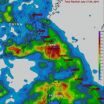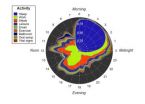(Press-News.org) A probiotic that prevents obesity could be on the horizon. Bacteria that produce a therapeutic compound in the gut inhibit weight gain, insulin resistance and other adverse effects of a high-fat diet in mice, Vanderbilt University investigators have discovered.
"Of course it's hard to speculate from mouse to human," said senior investigator Sean Davies, Ph.D., assistant professor of Pharmacology. "But essentially, we've prevented most of the negative consequences of obesity in mice, even though they're eating a high-fat diet."
Regulatory issues must be addressed before moving to human studies, Davies said, but the findings published in the August issue of the Journal of Clinical Investigation suggest that it may be possible to manipulate the bacterial residents of the gut — the gut microbiota — to treat obesity and other chronic diseases.
Davies has a long-standing interest in using probiotic bacteria — "friendly" bacteria like those in yogurt — to deliver drugs to the gut in a sustained manner, in order to eliminate the daily drug regimens associated with chronic diseases.
In 2007, he received a National Institutes of Health Director's New Innovator Award to develop and test the idea.
"The NIH basically said, 'we like this idea, now make it work,'" Davies said. "The New Innovator Award was critical to our success."
Other studies have demonstrated that the natural gut microbiota plays a role in obesity, diabetes and cardiovascular disease.
"The types of bacteria you have in your gut influence your risk for chronic diseases," Davies said. "We wondered if we could manipulate the gut microbiota in a way that would promote health."
To start, the team needed a safe bacterial strain that colonizes the human gut. They selected E. coli Nissle 1917, which has been used as a probiotic treatment for diarrhea since its discovery nearly 100 years ago.
They genetically modified the E. coli Nissle strain to produce a lipid compound called NAPE, which is normally synthesized in the small intestine in response to feeding. NAPE is rapidly converted to NAE, a compound that reduces both food intake and weight gain. Some evidence suggests that NAPE production may be reduced in individuals eating a high-fat diet.
"NAPE seemed like a great compound to try — since it's something that the host normally produces," Davies said.
The investigators added the NAPE-producing bacteria to the drinking water of mice eating a high-fat diet for eight weeks.
Mice that received the modified bacteria had dramatically lower food intake, body fat, insulin resistance and fatty liver compared to mice receiving control bacteria.
They found that these protective effects persisted for at least four weeks after the NAPE-producing bacteria were removed from the drinking water. And even 12 weeks after the modified bacteria were removed, the treated mice still had much lower body weight and body fat compared to the control mice. Active bacteria no longer persisted after about six weeks.
"We still haven't achieved our ultimate goal, which would be to do one treatment and then never have to administer the bacteria again," Davies said. "Six weeks is pretty long to have active bacteria, and the animals are still less obese 12 weeks out.
"This paper provides a proof of concept," he said. "Clearly, we can get enough bacteria to persist in the gut and have a sustained effect. We would like for that effect to last longer."
Davies noted that the researchers also observed effects of the compounds in the liver, suggesting that it may be possible to use modified bacteria to deliver therapeutics beyond the gut.
The investigators are currently working on strategies to address regulatory issues related to containing the bacteria, for example by knocking out genes required for the bacteria to live outside the treated host.
INFORMATION:
Zhongyi Chen, M.D., Ph.D., and Lilu Guo, Ph.D., are co-first authors of the JCI paper. This research was supported by the New Innovator Award (OD003137) and by other grants from the National Institutes of Health (AT007830, DK059637, DK020593, RR024975, DK092993).
Vanderbilt study examines bacteria's ability to fight obesity
2014-07-25
ELSE PRESS RELEASES FROM THIS DATE:
NSU researcher part of team studying ways to better predict intensity of hurricanes
2014-07-25
FORT LAUDERDALE-DAVIE, Fla. – They are something we take very seriously in Florida – hurricanes. The names roll off the tongue like a list of villains – Andrew, Charlie, Frances and Wilma.
In the past 25 years or so, experts have gradually been improving prediction of the course a storm may take. This is thanks to tremendous advancements in computer and satellite technology. While we still have the "cone of uncertainty" we've become familiar with watching television weather reports, today's models are more accurate than they used to be.
The one area, however, where ...
NASA maps Typhoon Matmo's Taiwan deluge
2014-07-25
When Typhoon Matmo crossed over the island nation of Taiwan it left tremendous amounts of rainfall in its wake. NASA used data from the TRMM satellite to calculate just how much rain fell over the nation.
The Tropical Rainfall Measuring Mission or TRMM satellite orbits the Earth and provides coverage over the tropics. TRMM is a satellite that is managed by both NASA and the Japan Aerospace Exploration Agency (JAXA) that acts as a "flying rain gauge in space," that can estimate how fast rain is falling within storms on Earth and how much rain has fallen.
On July 22, ...
Shift work linked to heightened risk of type 2 diabetes
2014-07-25
Shift work is linked to a heightened risk of developing type 2 diabetes, with the risk seemingly greatest among men and those working rotating shift patterns, indicates an analysis of the available evidence published online in Occupational & Environmental Medicine.
Previous research has suggested links between working shifts and a heightened risk of various health problems, including digestive disorders, certain cancers, and cardiovascular disease. But whether diabetes can be added to the list has not been clear.
The authors therefore trawled through scientific research ...
Smartphone experiment tracks whether our life story is written in our gut bacteria
2014-07-25
Life events such as visiting another country or contracting a disease cause a significant shift in the make-up of the gut microbiota – the community of bacteria living in the digestive system, according to research published in the open access journal Genome Biology.
Two participants used smartphone apps to collect information every day for a year in the study by scientists from MIT and Harvard. The authors think the method could be rolled out to studies of human-bacteria relationships with many more participants.
Our microbiota is the community of bacteria that share ...
Leaf-mining insects destroyed with the dinosaurs, others quickly appeared
2014-07-25
After the asteroid impact at the end of the Cretaceous period that triggered the dinosaurs' extinction and ushered in the Paleocene, leaf-mining insects in the western United States completely disappeared. Only a million years later, at Mexican Hat, in southeastern Montana, fossil leaves show diverse leaf-mining traces from new insects that were not present during the Cretaceous, according to paleontologists.
"Our results indicate both that leaf-mining diversity at Mexican Hat is even higher than previously recognized, and equally importantly, that none of the Mexican ...
Monitoring the rise and fall of the microbiome
2014-07-25
CAMBRIDGE, MA -- Trillions of bacteria live in each person's digestive tract. Scientists believe that some of these bacteria help digest food and stave off harmful infections, but their role in human health is not well understood.
To help shed light on the role of these bacteria, a team of researchers led by MIT associate professor Eric Alm recently tracked fluctuations in the bacterial populations of two research subjects over a full year. The findings, described in the July 25 issue of the journal Genome Biology, suggest that while these populations are fairly stable, ...
Atomic structure of key muscle component revealed in Penn study
2014-07-25
VIDEO:
This is a representation of the atomic structure of tropomodulin at the minus end of the actin filament in muscle sarcomeres. Tropomodulin interacts with the first three actin subunits of...
Click here for more information.
PHILADELPHIA - Actin is the most abundant protein in the body, and when you look more closely at its fundamental role in life, it's easy to see why. It is the basis of most movement in the body, and all cells and components within them have the capacity ...
Increased risk for head, neck cancers in patients with diabetes
2014-07-25
Diabetes mellitus (DM) appears to increase the risk for head and neck cancer (HNC). Evidence suggests certain cancers are more common in people with DM, but the risk of HNC in patients with DM has not been well explored. Overall, head and neck cancer is the sixth most common type of cancer. It accounts for about 6 percent of all cases and for an estimated 650,000 new cancer cases and 350,000 cancer deaths worldwide each year.
The authors used Taiwan's Longitudinal Health Insurance Research Database to examine the risk of HNC in patients with DM. The authors compared 89,089 ...
8.2 percent of our DNA is 'functional'
2014-07-25
Only 8.2% of human DNA is likely to be doing something important – is 'functional' – say Oxford University researchers.
This figure is very different from one given in 2012, when some scientists involved in the ENCODE (Encyclopedia of DNA Elements) project stated that 80% of our genome has some biochemical function.
That claim has been controversial, with many in the field arguing that the biochemical definition of 'function' was too broad – that just because an activity on DNA occurs, it does not necessarily have a consequence; for functionality you need to demonstrate ...
Invertebrate numbers nearly halve as human population doubles
2014-07-25
Invertebrate numbers have decreased by 45% on average over a 35 year period in which the human population doubled, reports a study on the impact of humans on declining animal numbers. This decline matters because of the enormous benefits invertebrates such as insects, spiders, crustaceans, slugs and worms bring to our day-to-day lives, including pollination and pest control for crops, decomposition for nutrient cycling, water filtration and human health.
The study, published in Science and led by UCL, Stanford and UCSB, focused on the demise of invertebrates in particular, ...



